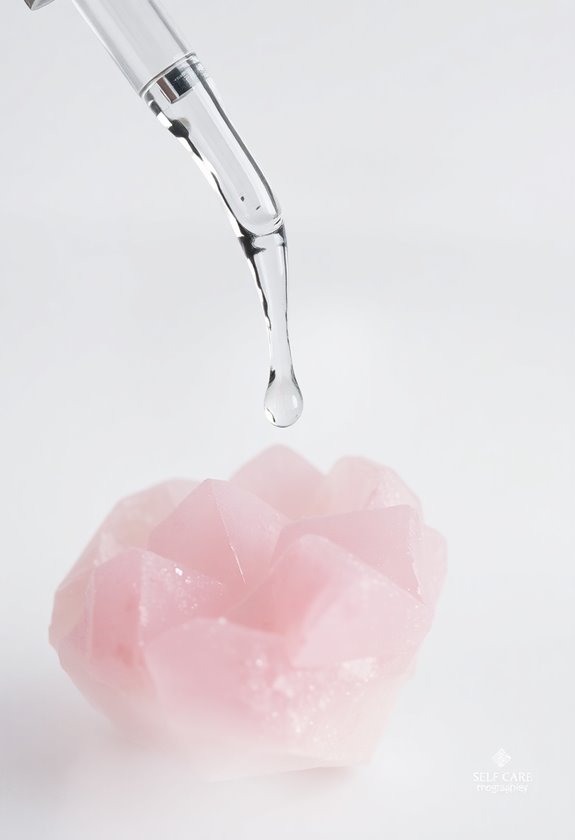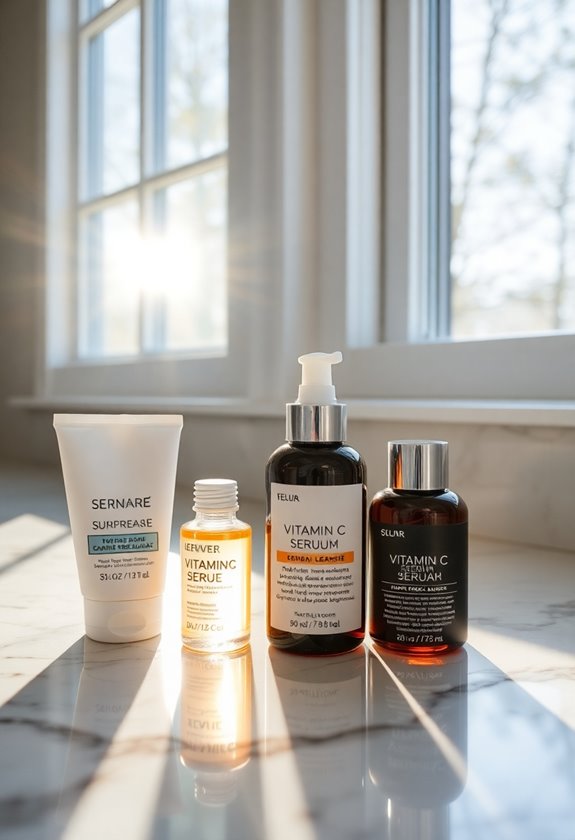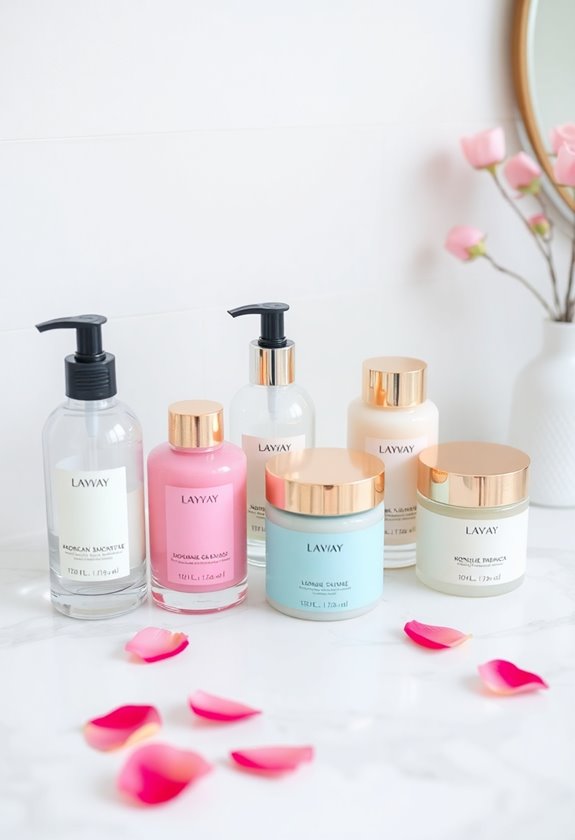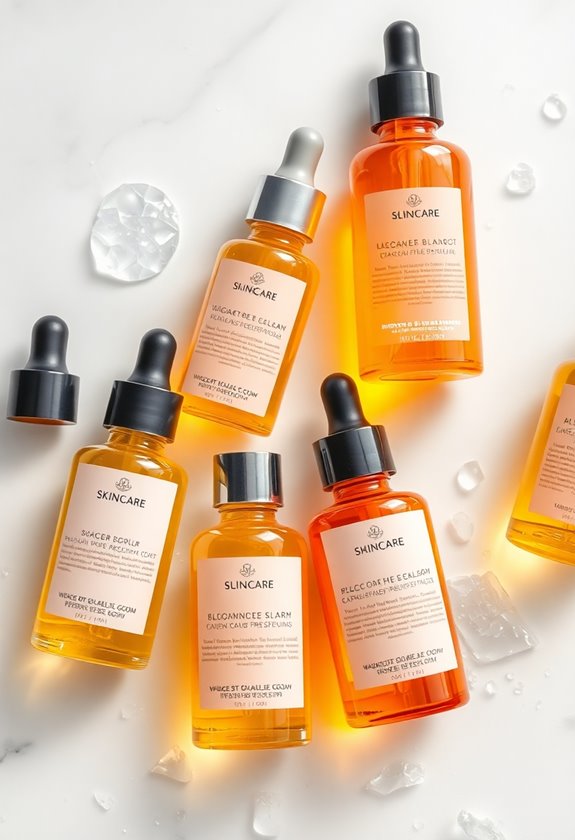To maximize hyaluronic acid's benefits, start with freshly cleansed skin and leave it slightly damp. Apply a pea-sized amount of serum to your palms, then gently press and pat the product onto your face and neck. You'll want to seal in the hydration within 60 seconds by applying moisturizer on top. Use hyaluronic acid twice daily, incorporating it after toners but before heavier products like retinol or moisturizers. For enhanced results, consider applying to skin that's been misted with water, especially in dry climates. While you'll notice immediate plumping effects, the most dramatic improvements emerge through consistent application and proper technique.
Highlights
- Apply to damp skin after cleansing, as hyaluronic acid needs moisture to effectively hydrate and penetrate the skin.
- Use a pea-sized amount and gently pat the serum into skin, avoiding rubbing or aggressive application techniques.
- Seal with moisturizer within 60 seconds of application to lock in hydration and prevent moisture loss.
- Layer correctly: apply after toner but before heavier products like moisturizers and oils for optimal absorption.
- Apply twice daily, morning and evening, using the damp skin method and following with complementary products as needed.
What Makes Hyaluronic Acid Special

From deep within our skin to the latest beauty products, hyaluronic acid stands out as a remarkable moisturizing compound that can hold up to 1,000 times its weight in water. This naturally occurring substance keeps your skin plump, hydrated, and youthful-looking while supporting the body's natural healing processes.
You'll find hyaluronic acid particularly special because:
- It's already present in your body, making it highly compatible with your skin
- It works for all skin types, from dry to oily, without causing irritation
- It penetrates deeply into your skin while creating a protective barrier on the surface
- It helps reduce fine lines and wrinkles by maintaining ideal moisture levels
- It enhances your skin's ability to repair itself, especially when combined with other active ingredients
When to Apply Hyaluronic Acid
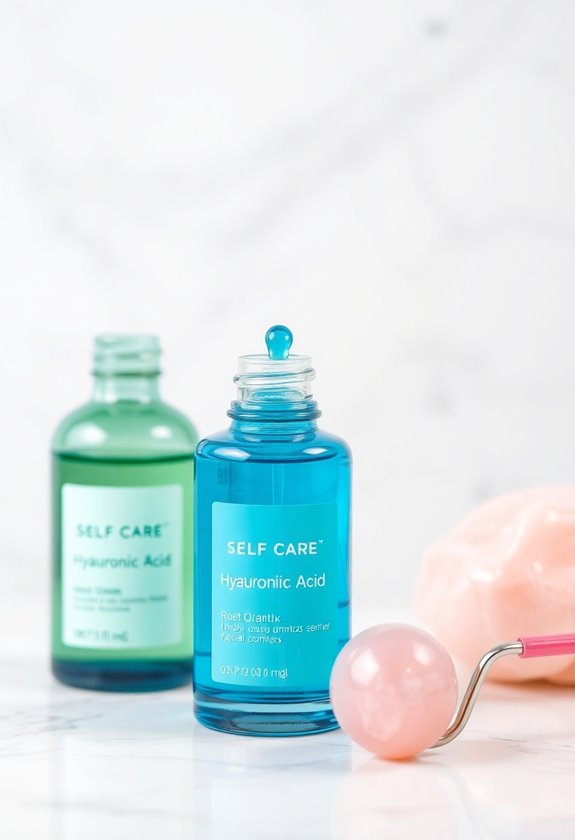
Timing plays an essential role in maximizing the benefits of hyaluronic acid in your skincare routine. You'll want to apply it immediately after cleansing while your skin is still slightly damp, which helps the molecule attract and bind water more effectively.
For best results, follow these specific timing guidelines:
- Apply hyaluronic acid twice daily – morning and evening – as part of your regular skincare routine
- Use it before heavier products like moisturizers and oils, but after any water-based toners
- If you're using vitamin C serum in the morning, apply that first, then wait 30 seconds before applying hyaluronic acid
- When using retinol at night, layer hyaluronic acid first to reduce potential irritation
Always seal in hyaluronic acid with a moisturizer within 60 seconds of application to lock in hydration.
Prep Your Skin First

Proper skin preparation creates the perfect foundation for hyaluronic acid to work effectively. Begin by thoroughly cleansing your face with a gentle, pH-balanced cleanser that won't strip your skin of its natural oils. Using facial moisturizer products daily helps maintain your skin's natural barrier function before applying treatments.
- First, use lukewarm water to wash your face, as hot water can be too harsh and irritating for your skin.
- Next, apply your cleanser using gentle circular motions, making sure to remove all traces of dirt, oil, and makeup from your skin's surface.
- After cleansing, pat your face gently with a clean towel until it's slightly damp but not completely dry, which will help the hyaluronic acid penetrate more effectively.
- If you're using a toner, apply it now while your skin is still slightly moist to maintain ideal hydration levels.
The Damp Skin Method
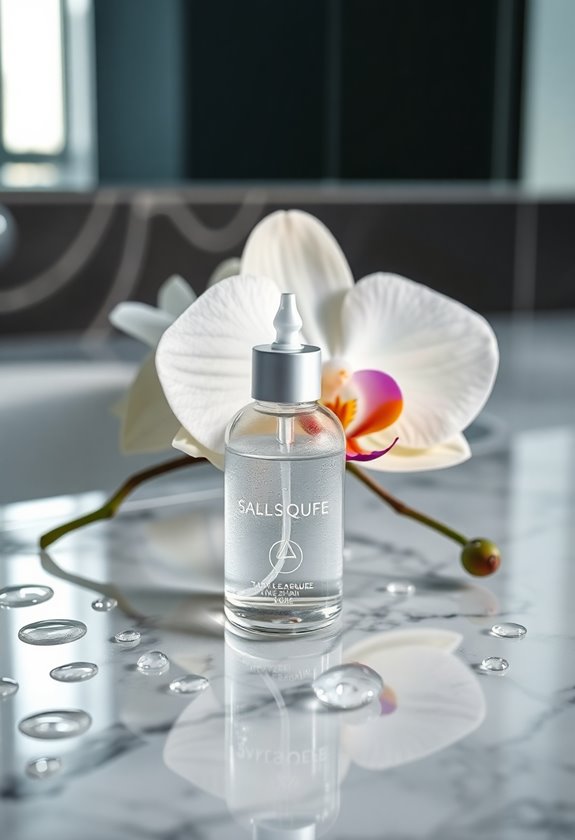
For maximum effectiveness, applying hyaluronic acid to damp skin is essential. The science behind this method is straightforward: hyaluronic acid works by drawing moisture from its surroundings, and when your skin is slightly wet, it has immediate access to that hydration.
Here's how to use the damp skin method properly:
- Cleanse your face thoroughly and pat it until it's just slightly damp
- Apply a few drops of hyaluronic acid serum to your palm
- Quickly press and pat the serum onto your face while your skin is still damp
- Follow immediately with your moisturizer to seal in the hydration
If you're in a dry climate, you can mist your face with water first, as this gives the hyaluronic acid more moisture to work with.
Layering Products With Hyaluronic Acid

Building on the damp skin application method, understanding how to layer hyaluronic acid with other skincare products will maximize its benefits. For optimal results, consider storing your hyaluronic acid serum in a skincare fridge to enhance its cooling and depuffing effects. When incorporating hyaluronic acid into your routine, follow a specific order to guarantee ideal absorption and effectiveness of each product.
- Start with your thinnest products first, such as toners or essences, which prepare your skin for the hyaluronic acid serum
- Apply your hyaluronic acid serum while your skin is still slightly damp from the previous step
- Wait approximately 30 seconds for the hyaluronic acid to absorb before applying thicker products like moisturizers or facial oils
- Finish with sunscreen during your morning routine, as it should always be the final step in your skincare regimen to guarantee proper protection
Common Application Mistakes
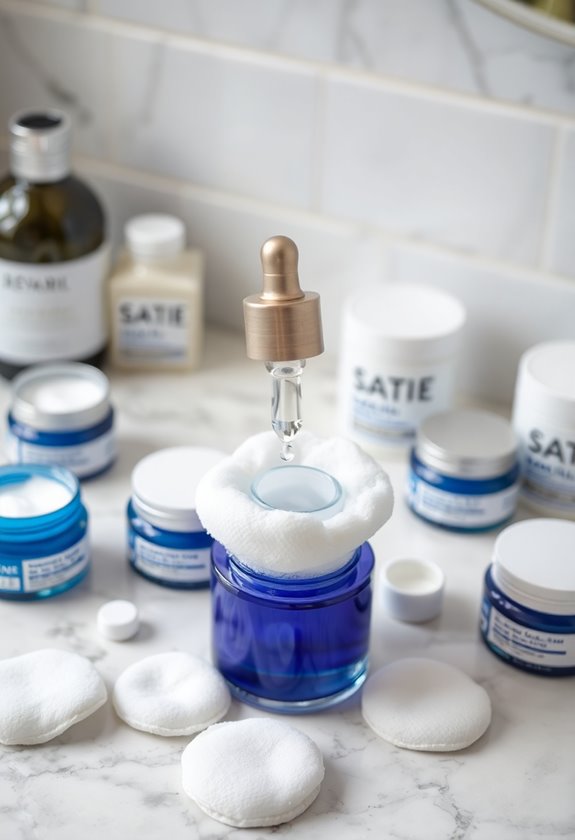
While hyaluronic acid offers remarkable benefits, many skincare enthusiasts make several common mistakes that can reduce its effectiveness or even worsen their skin concerns.
- Applying hyaluronic acid to dry skin without dampening it first, which can actually draw moisture from deeper skin layers
- Using too much product, when just a pea-sized amount is typically sufficient for your entire face
- Not sealing the hyaluronic acid with a moisturizer, allowing the hydration to evaporate from your skin
- Layering it incorrectly by putting it on after heavier products that prevent proper absorption
- Choosing products with molecular weights that don't match your skin concerns, such as using only high-molecular-weight HA when you need deeper penetration
- Skipping the neck area, which needs hydration just as much as your face
Best Time of Day
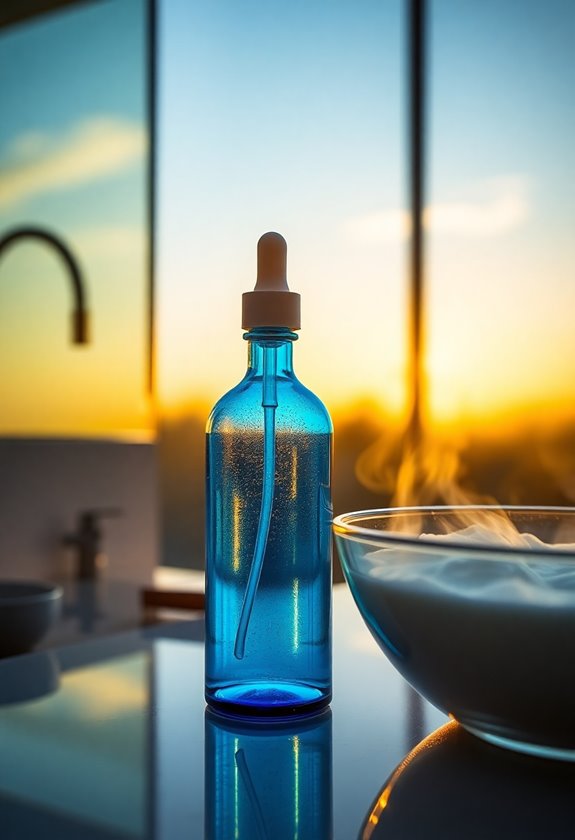
When it comes to applying hyaluronic acid, you can use it both morning and night as part of your skincare routine. For best results, you'll want to time your application strategically to maximize the product's hydrating benefits and guarantee proper absorption into your skin.
- Morning application works best right after cleansing, while your skin is still slightly damp from washing your face
- Evening application should happen after cleansing but before heavier products like moisturizers or night creams
- If you're using multiple serums, apply hyaluronic acid immediately after water-based products but before oil-based ones
- For enhanced absorption, try applying within 60 seconds of washing your face, when your skin's moisture barrier is most receptive to the product
Consider following up your hyaluronic acid application with a hydrating face mask to lock in moisture and boost the effectiveness of your skincare routine.
Amount to Use

Knowing the right time to apply hyaluronic acid is just half the equation – using the correct amount guarantees you'll get ideal results without wasting product. For most serums, you'll want to use about a pea-sized amount (approximately 2-3 drops) for your entire face and neck area.
When using a hyaluronic acid product, start with clean, slightly damp skin and dispense the product onto your fingertips. If you're using a more concentrated formula (anything above 2% concentration), you might want to use slightly less to prevent potential irritation or tackiness. For larger areas like your chest or neck, you can add an extra drop, but don't exceed more than 4-5 drops total per application, as using too much won't increase the benefits.
Storage and Product Shelf Life
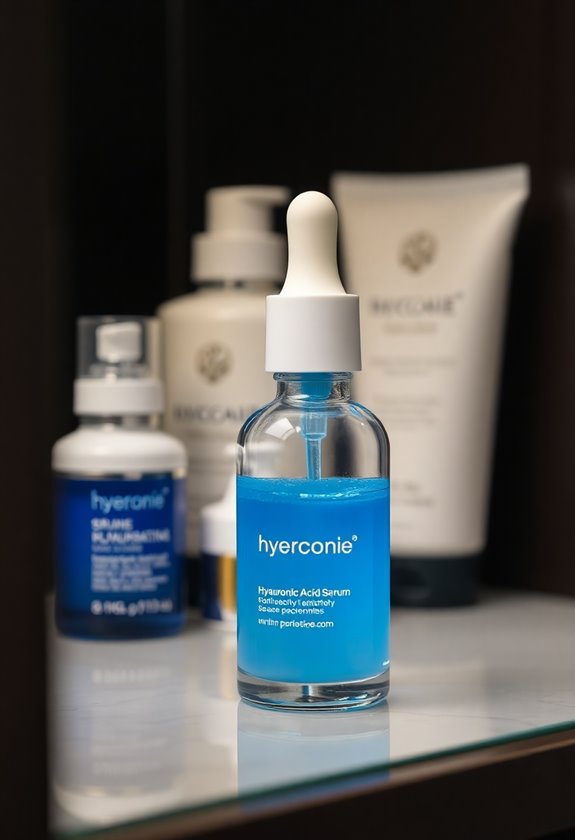
To maintain its effectiveness, hyaluronic acid should be stored in a cool, dark place away from direct sunlight and extreme temperatures. Most hyaluronic acid products will remain stable for 12-24 months when stored properly, but you'll want to check the expiration date on your specific product.
- Keep your hyaluronic acid serum in its original container, as it's designed to protect the formula from light and air exposure
- Store your product at room temperature (between 60-75°F), and don't leave it in hot bathrooms or near heating vents
- Check for changes in color, consistency, or smell, which could indicate your product has degraded
- Write the date you've opened your product on the bottle, as most serums should be used within 6-12 months after opening
Results and Timeline
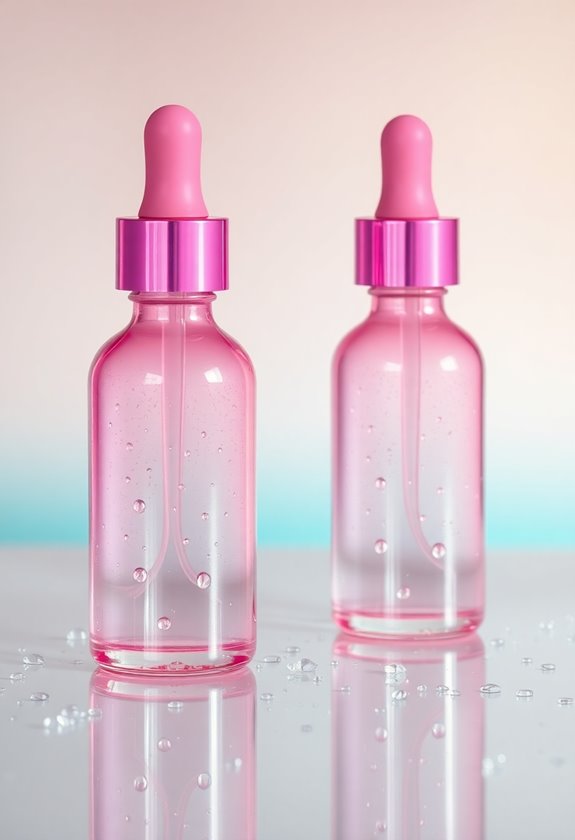
Most people notice initial results from hyaluronic acid within the first few weeks of consistent use. You'll likely see immediate plumping and hydration effects within minutes of application, but the long-term benefits develop over time with regular use.
For ideal results, you'll need to maintain your hyaluronic acid routine for at least 6-8 weeks. Here's what to expect:
- Days 1-7: Immediate surface hydration and temporary plumping
- Weeks 2-4: Reduced appearance of fine lines and improved skin texture
- Weeks 4-8: More noticeable improvements in skin firmness and overall hydration
- Beyond 8 weeks: Long-term benefits including sustained moisture retention and stronger skin barrier
Remember that results can vary based on your skin type, product concentration, and how consistently you're using the product. Many people choose to complement their skincare routine by adding vitamin C serum for enhanced skin-brightening benefits.
Frequently Asked Questions
Can Pregnant Women Safely Use Hyaluronic Acid?
Yes, you can safely use hyaluronic acid during pregnancy, as it's naturally present in your body and considered non-toxic. Your skin actually produces this moisture-binding molecule, making it a pregnancy-safe ingredient for skincare. When you're selecting products, opt for pure hyaluronic acid formulations rather than combination products, and it's always wise to check with your healthcare provider first.
Does Hyaluronic Acid Work Differently on Different Skin Tones?
Like a gentle rain that nourishes all gardens equally, hyaluronic acid works the same way across all skin tones. You'll find that this moisturizing molecule doesn't discriminate based on melanin levels, as it penetrates and hydrates skin cells universally. While different skin tones may have varying concerns or sensitivities that need addressing, your skin's ability to absorb and benefit from hyaluronic acid remains consistent regardless of your complexion.
Can Hyaluronic Acid Make Acne or Rosacea Worse?
Hyaluronic acid typically won't make acne or rosacea worse, as it's a gentle hydrating ingredient that's naturally present in your skin. However, if you're using a formula that's too heavy or contains other irritating ingredients, you might experience increased sensitivity. For rosacea-prone skin, you'll want to choose a lightweight hyaluronic acid serum and apply it to damp skin, avoiding any products with added fragrances or potential irritants.
Is It Safe to Make DIY Hyaluronic Acid Serums at Home?
While it's possible to make hyaluronic acid serums at home, it's not recommended due to several safety concerns. You'll need precise measurements, sterile equipment, and proper preservatives to prevent bacterial growth, which can lead to skin infections. DIY formulations also risk improper pH levels and ingredient concentrations that could irritate your skin. It's safer and more reliable to purchase professionally formulated hyaluronic acid products.
Should You Stop Using Hyaluronic Acid Before Surgical Procedures?
You'll need to stop using hyaluronic acid products at least one week before any surgical procedure, as it can interfere with blood clotting and healing processes. While hyaluronic acid is generally safe for daily skincare, your surgeon may have specific requirements about discontinuing its use. Always disclose your complete skincare routine during pre-surgical consultations to guarantee the safest possible outcome for your procedure.

